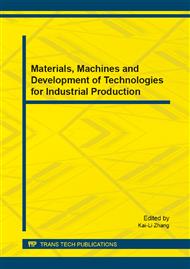[1]
Meng Luo. Mechanism and Control Methods of Burr Formation in Metal Cutting Process [D]. Shanghai JIAOTONG University, 2007: 8-22.
Google Scholar
[2]
Qin-xi Shen, et al. The forecast or prediction of burrs in metal cutting [J]. Machinery Design & Manufacture, 2009(1): 237-239.
Google Scholar
[3]
Lie-run Rong. Surface Finishing Technology and Application [J]. Technique, 2012(13); 37-40.
Google Scholar
[4]
Gui-cheng Wang, Chun-ye Zhang. Machining theory and technology generating minimum cutting burrs. Proceedings of the 5th International Conference on Frontiers of Design and Manufacturing, Vol. 2, (2002).
Google Scholar
[5]
Gui-cheng Wang et al. Development of the Expert System for Metal Cutting Burr [J]. 2004, 33(10): 116-118.
Google Scholar
[6]
Yun-ming Zhu, Gui-cheng Wang. Edge quality of precision parts and measuring method[J]. Machinery, 2003, 41(465): 50-52.
Google Scholar
[7]
Wu-yi Zhang, Qiang-song Zhao, Dong-yun Wang. Actualities and Developing Trend Of Machine Vision[J]. Journal if Zhongyuan University of Technology, 2008, 19(1): 9-15.
Google Scholar
[8]
Qiao-fen Zhang, Jian Gao. Research Progress of Lighting Technology in Machine Vision[J]. China Illuminating Engineering Journal, 2011, 22(2): 31-36.
Google Scholar
[9]
Yun-fang Zhang. Water Area of Remote Sensing Image Edge Detection Method Based on Morphology Top-Hat and Bottom-Hat [J]. Urban Geotechnical Investigation & Surveying, 2009(01): 80-82.
Google Scholar
[10]
Yi-quan Wu, Zhao-da Zhu. 30 years (1962-1992) of developments in the threshold selection methods in image processing (I) [J]. Journal of Data Acquisition & Processing, 1993, 8(3): 193-201, 268-281.
Google Scholar
[11]
SEZGIN M. Survey over image thresholding techniques and quantitative performance evaluation [J]. Journal of Electronic Image. 2004, 13(1): 146-165.
DOI: 10.1117/1.1631315
Google Scholar
[12]
Otsu N, A threshold selection method from gray-level histograms [J]. IEEE Transactions on System Man and Cybernetic, 1979, 9(1): 62-66.
DOI: 10.1109/tsmc.1979.4310076
Google Scholar
[13]
Dunn S M, Harwood D, Davis L S, Local estimation of the uniform error threshold [J]. IEEE Transactions on System Man and Cybernetic, 1984, 6(6): 742-745.
Google Scholar
[14]
Kapur J N, Sahoo P K, Wong A K C. A new method for gray-level picture thiresholding using the entropy of the histogram [J]. Computer Vision, Graphics and image Processing, 1985, 29: 273-285.
DOI: 10.1016/0734-189x(85)90125-2
Google Scholar
[15]
Kittler J, Illingworth J. Minimum error thresholding [J]. Pattern Recognition, 1986, 19(1): 41-47.
DOI: 10.1016/0031-3203(86)90030-0
Google Scholar


